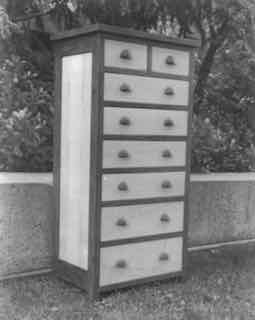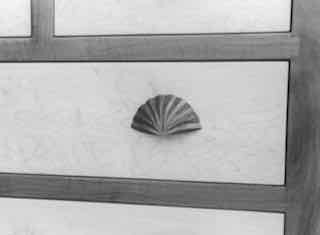
Tom McFadden
F U R N I T U R E
P.O. Box 162 - Philo, CA 95466 - (707) 895-3606
www.mcfaddenfurniture.com - tamcfad@pacific.net
Chest

|
This is the chest of drawers that I was asked to make after I finished doing cabinets for one of David Clayton’s clients. The frame is Walnut and the panels and drawer
fronts are Birdseye Maple. The top is solid Walnut and hangs over the sides and front, a detail that I changed in later chests. I had tried making pulls with grapes and
grape leaves and those were quite clumsily done, and when this client requested seashell pulls I thought correctly that seashells would be easier. I have continued putting
this seashell pull on my chests of drawers ever since. I have probably carved hundreds of them. I wrote an article for “Fine Woodworking” on how I do it. Issue #29.
|

|
This is a detail shot of one of the two chests, included here because it was on this project that I developed my own system of case construction. The horizontal rails are through dovetailed to the legs in the front and the back, and they are connected by Maple drawer runners that are stub tenoned into them. The vertical drawer divider is done the same way, but it has an additional piece in it to serve as a side guide for the drawer on each side of it. The ends are mortised and tenoned and the panel floats in a slot cut for it. There is a Maple drawer guide doweled into the legs flush with the inside of the legs. The back is 1/4 inch plywood let into a rabbit run the back of the legs and screwed to the back horizontal members. This system makes for a very strong carcass that allows for wood movement. The drawers are guided top and bottom and on both sides. I would make wooden stops for the drawers and screw them to the legs in the back. All backs were attached with screws so that they could be taken off should someone need to work on the chest in the future. The drawers have hard Maple sides which are dovetailed to the fronts and backs. The drawer bottoms are aromatic cedar plywood left unfinished. Mortising methods changed, and I soon began to run the legs and top rails up past the top so that the front rail would be locked in with both sides of a dovetail, but this is typical construction of my case goods through to the present day. |